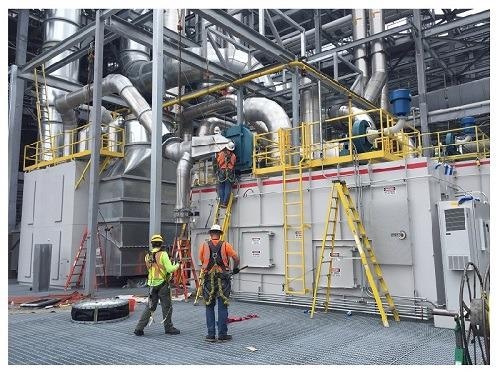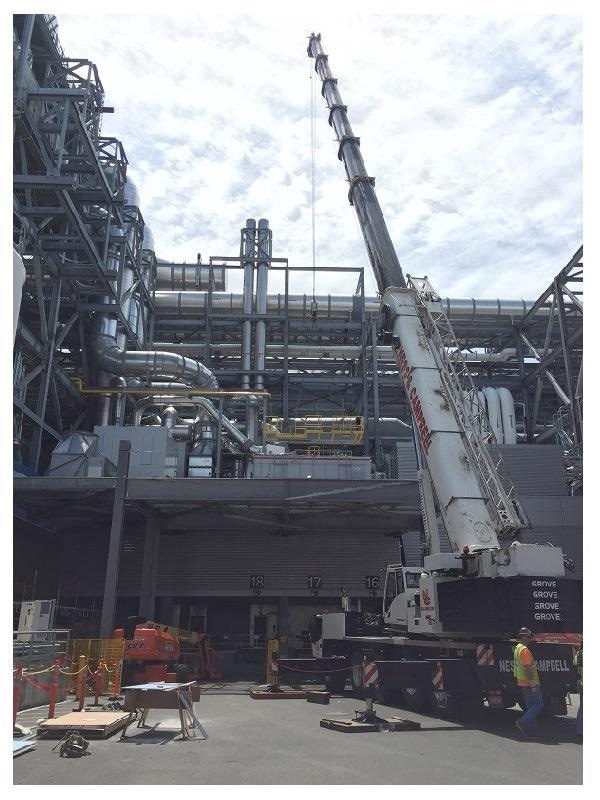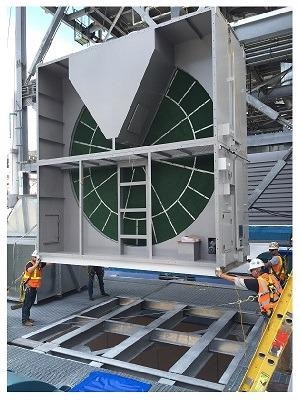As the global chip shortage continues, semiconductor manufacturers are scrambling to increase manufacturing capacity in order to meet extraordinary levels of demand.

Image Credit: Anguil Environmental Systems
Due to air quality regulations requiring that semiconductor facilities eliminate or reduce their emissions at the source, larger fabrication plants often have to install two or three (or more) separate air pollution abatement systems to comply with regulations. Anguil’s ultra-high-throughput air pollution control systems offer an alternative, enabling manufacturers to expand capacity and meet environmental regulations while saving millions of dollars.
The Semiconductor Industry is Gearing Up for Increased Production
The world is currently in the grips of a semiconductor drought, caused by rapidly fluctuating demand and a slew of supply chain issues.
The COVID-19 pandemic triggered a massive drop in demand for new vehicles at the start of 2020, which caused automobile manufacturers to curtail production drastically.1 In a world where microchip-based electronics play an increasing role in vehicles – accounting for up to 40% of the cost of a new car – this initially resulted in a severe reduction in demand for semiconductors for the automotive industry.
At the same time, however, the pandemic caused a huge surge in demand for PCs, gaming consoles, and communications equipment for a largely locked-down global population. As a result of this drastic shift in demand, major semiconductor manufacturers all but ceased production of car components, turning over production capacity to laptop, smartphone, and tablet chips.2,3
With car sales on the rise again, semiconductor manufacturers around the world are now fighting to ramp up production to meet the twin demands of high-tech vehicles and consumer electronics. In terms of sales, the semiconductor industry is doing better than ever.4 But increasing semiconductor output is not easy: semiconductor fabrication equipment is enormously expensive, and new fabrication plants (known as “fabs”) can take several years to complete. As a result, Taiwanese semiconductor giants TSMC predict that the global shortage will continue until 2022.5

Image Credit: Anguil Environmental Systems
The race is on to increase capacity and meet the highest levels of demand the industry has ever seen. The EU has announced plans to diversify supply chains and increase the domestic output of semiconductors, entering discussions with Samsung, Intel, and TSMC about the construction of a European fabrication plant.6 The US government has proposed a US$50 billion stimulus for semiconductor manufacturing, while the South Korean government plans to develop the world’s largest semiconductor supply chain – with investment totaling over US$450 billion – by 2030.7,8 The next few years will likely see an explosion in semiconductor output worldwide and a trend towards larger fabrication lines such as Intel’s proposed facility in Arizona.
The Environmental Toll of Semiconductor Manufacturing
Despite heavy government backing, the semiconductor industry has an enormous environmental impact. A 2020 report produced by researchers at Harvard University, Facebook, and Arizona State University established that chip manufacturing – as opposed to hardware use and energy consumption – accounts for the majority of carbon emissions associated with the semiconductor life cycle.9 The amount of air pollution produced onsite at a semiconductor fab can also be huge: this is composed mainly of volatile organic compounds (VOCs), as well as acidic and alkaline gases.
With many governments backing the expansion of semiconductor production, the industry collectively relies on standards for manufacturing under the Responsible Businesses Alliance (RBA). The RBA sets out strict standards and guidelines for its members – which include the likes of Intel, Samsung, Fujitsu, and Nvidia – designed to minimize (or eliminate, where possible) pollutants and waste at the source.10
One of the primary ways this is accomplished is through air pollution control (or pollution abatement) systems.
Anguil is Overcoming Pollution Control Challenges in the Semiconductor Industry
Air pollution control devices are crucial in enabling semiconductor manufacturers to filter out harmful emissions – primarily VOCs – from the air. However, in the absence of sufficiently large air pollution control systems, many larger semiconductor manufacturers are forced to install multiple systems to reach the required rates of air filtration. Installing multiple air pollution control systems is not only inefficient in terms of cost; but, in an industry where floor space is extremely valuable, the space taken up by these systems represents a colossal long-term expenditure.
With more and more large-scale fabs being constructed the need for high-capacity air filtration systems is greater than ever.11
Anguil is meeting this demand with custom-engineered air pollution control systems designed from the ground up to meet the demands of growing semiconductor industry. The driving technology behind Anguil’s systems is their emission concentration: A large volume of process exhaust is then condensed into a much smaller and more concentrated air stream, which is then sent to a thermal oxidizer for destruction.12

Image Credit: Anguil Environmental Systems
Anguil emission concentrators have the largest flow capacity in the industry at approximately 200,000 normal cubic meters per hour (Nm3/h). Installation costs of pollution abatement systems are typically three to four times the capital cost of the equipment. However, the emission concentration process means that Anguil air pollution control systems can reduce equipment size by 90-95% compared to competing systems; providing dramatic reductions in capital, installation, and operating costs.
Anguil works closely with customers to develop their Rotor Concentrator Thermal Oxidizer (RCTO) to meet new standards of throughput, equipment size, destruction requirements and energy efficiency. The latest iteration of the RCTO is not only able to handle very large air volumes but efficiently deal with very high VOC loading concentrations too. The fully “universal” design means that the RCTO can be installed at any facility around the world, giving semiconductor manufacturers the flexibility to move units from one facility to another to meet production demands. It also means that manufacturers can order multiple units before deciding which facilities they will be sent to.
Anguil’s air pollution abatement systems ensure that the global semiconductor industry will be able to meet demand while adhering to (and often exceeding) air quality regulations.
References and Further Reading
1. Understanding COVID-19’s impact on the automotive sector | Deloitte Global. Deloitte. Online at: https://www.deloitte.com/global/en/issues/resilience/understanding-covid-19-s-impact-on-the-automotive-sector.html.
2. Chin, M. The pandemic has made it harder to buy a new laptop. The Verge. Online at: https://www.theverge.com/2020/6/4/21279633/laptop-pc-shortages-supply-chain-coronavirus-covid-19-pandemic (2020).
3. Sparkes, M. There’s a global shortage of computer chips – what’s causing it? New Scientist. Online at: https://www.newscientist.com/article/2271918-theres-a-global-shortage-of-computer-chips-whats-causing-it/.
4. Ravi, S. Global Semiconductor Sales Increase 13.2% year-to-year in January. Semiconductor Industry Association. Online at:https://www.semiconductors.org/global-semiconductor-sales-increase-13-2-year-to-year-in-january/(2021).
5. TSMC Lifts Targets After Warning Chip Crunch May Hit 2022. Bloomberg.com (2021).
6. Welle (www.dw.com), D. The EU’s microchip dilemma: Too little or too late? | DW | 29.04.2021. DW.COM. Online at: https://www.dw.com/en/the-eus-microchip-dilemma-too-little-or-too-late/a-57367537.
7. Clark, D. ‘It’s a Roller-Coaster Ride’: Global Chip Shortage Is Making Industries Sweat. The New York Times (2021).
8. Korea Unveils $450 Billion Push for Global Chipmaking Crown - Bloomberg. Online at: https://www.bloomberg.com/news/articles/2021-05-13/korea-unveils-450-billion-push-to-seize-global-chipmaking-crown.
9. Gupta, U. et al. Chasing Carbon: The Elusive Environmental Footprint of Computing. arXiv:2011.02839 [cs] (2020).
10. RBA | Code of Conduct (2021). Online at: https://www.responsiblebusiness.org/code-of-conduct/.
11. Intel CEO Announces ‘IDM 2.0’ Strategy for Manufacturing, Innovation. Intel. Online at: https://www.intel.com/content/www/us/en/newsroom/news/idm-manufacturing-innovation-product-leadership.html.
12. Emission Concentrator | Manufacturer. Anguil Environmental Systems, Inc. Online at: https://anguil.com/air-pollution-control-solutions/emission-concentrator/.
13. Chips in a crisis. Nat Electron 4, 317–317 (2021).